The Karl J. R. Arndt Collection of Charles Sealsfield
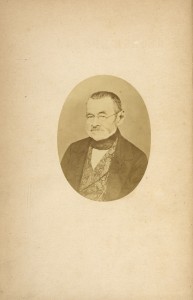 Mrs. Blanca H. Arndt of Worcester has donated to AAS the remarkable collection of works by and about the German-American author Charles Sealsfield (1793-1864) formed by her late husband, Karl J. R. Arndt. Numbering some 250 volumes, with accompanying research files, the Arndt gift elevates AAS’s Sealsfield holdings from passable to world-class.
Mrs. Blanca H. Arndt of Worcester has donated to AAS the remarkable collection of works by and about the German-American author Charles Sealsfield (1793-1864) formed by her late husband, Karl J. R. Arndt. Numbering some 250 volumes, with accompanying research files, the Arndt gift elevates AAS’s Sealsfield holdings from passable to world-class.
Although the Arndt gift contains few American imprints, its relevance for AAS is clear. Born Karl Postl in Moravia, Sealsfield entered a Prague monastery in 1814. By 1823 Postl had tired of the stifling religious and political climate and, breaking his vows, fled under threat of arrest to the United States. There he created a new identity as “Charles Sealsfield.” During the 1820s Sealsfield traveled widely in Texas, Mexico, Louisiana, and northward through Pennsylvania and New York, eventually establishing himself as a journalist, novelist, and canny observer of American life. His first novel, Tokeah, or, the white rose (1829) was written in English and published anonymously in Philadelphia to modest success. Though now a U.S. citizen, Sealsfield moved to Switzerland in 1830, where he spent most of his remaining years, his true identity kept secret until after his death.
In Switzerland Sealsfield wrote prolifically (now in German), publishing an entire shelf of novels before retiring in 1843. Drawing upon his American experiences, Sealsfield pioneered a new kind of “ethnographic” novel, taking as his theme the confrontation between white Americans and the various ethnic populations sharing the expansive American landscape. His novels proved enormously popular in German-speaking Europe, and when several were translated into English in the early 1840s, Sealsfield’s fame spread to England and back to the United States. No longer could the “Great Unknown,” as his readers called him, continue to publish his works anonymously, and the name Charles Sealsfield (sometimes “Seatsfield”) was henceforth added to their title pages. Although Sealsfield’s American reputation soon waned, he (and his later imitator Karl May (1842-1912)) introduced generations of German readers to the American West. Sealsfield’s influence upon American writers such as Longfellow is well documented, and his career epitomizes the dangers of defining “American” literature and authorship too narrowly. With the Arndt gift, AAS’s superb American literary holdings can be situated in a more properly nuanced context.
Karl Arndt (1903-1991), professor of German at Clark University, pursued many interests during a long and distinguished career. An AAS member, Arndt mined the collections heavily for many scholarly projects on Germans in 18th– and 19-century America, most notably his studies of the Harmony Societies in Pennsylvania and Indiana, the German-language press in America, and, of course, Sealsfield. His many publications include the definitive bibliographies The first century of German language printing in the United States of America (1989), and The German language press of the Americas (1973-1980).
Like many comprehensive collections, Karl Arndt’s Sealsfield holdings were not formed one volume at a time. Rather, Arndt purchased the collections of Sealsfield’s two primary bibliographers—the American scholar (and Arndt’s mentor) Otto Heller (1863-1941) of Washington University in St. Louis, and Albert Kresse (1886-1961) of Stuttgart—and then he built upon that solid foundation. A scholar as well as a collector, Arndt used his library for a number of articles and as a resource for editing Sealsfield’s collected works (Hildesheim, 1972- ; 28 v. to date). Hence the copies given to AAS have already had a distinguished, sustained impact upon Sealsfield scholarship. And preserved in perpetuity at AAS, they will continue to do so thanks to the thoughtful generosity of Blanca Arndt.
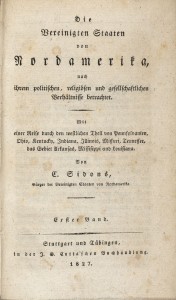 Die Vereinigten Staaten von Nordamerika, nach ihrem politischen, religiösen und gesellschaftlichen Verhältnisse betrachtet … Stuttgart & Tübingen: J. G. Cotta, 1827.
Die Vereinigten Staaten von Nordamerika, nach ihrem politischen, religiösen und gesellschaftlichen Verhältnisse betrachtet … Stuttgart & Tübingen: J. G. Cotta, 1827.
Sealsfield published his first book under the pseudonym “C. Sidons,” which he never again employed. The first volume offers an overview of American political institutions (including the rise of Jacksonianism), society, and culture, while the second takes the reader on an extended tour of the Mississippi and Ohio River valleys.
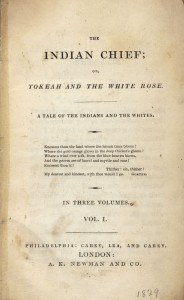 The Indian chief; or, Tokeah and the white rose. A tale of the Indians and the whites. Philadelphia: Carey, Lea, and Carey; London: A. K. Newman, 1829.
The Indian chief; or, Tokeah and the white rose. A tale of the Indians and the whites. Philadelphia: Carey, Lea, and Carey; London: A. K. Newman, 1829.
Sealsfield’s first novel is set in the lower Mississippi valley during the War of 1812, where Creek Indians struggled to protect their lands and culture from unscrupulous whites. Originally issued in two volumes in Philadelphia, this rare three-volume second edition was printed in London and bears an unusual transatlantic joint imprint. Arndt knew of only one other copy—at the British Library—though a few others have since turned up.
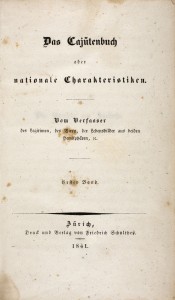 Das Cajütenbuch oder nationale Charakteristiken. Zürich: Friedrich Schultess, 1841.
Das Cajütenbuch oder nationale Charakteristiken. Zürich: Friedrich Schultess, 1841.
Das Cajütenbuch (The Cabin book) is Sealsfield’s best-known work and one of the earliest novels to be set in Texas. In a series of five tales related at a fictional dinner party, Sealsfield offers a portrait of Texas and its settlers during the struggle for independence from Mexico.
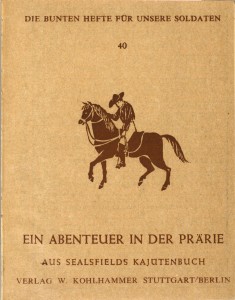 Ein Abenteuer in der Prärie, aus Sealsfields Kajütenbuch. Stuttgart: Verlag W. Kohlhammer, 1944. (Die bunten Hefte für unsere Soldaten, 40)
Ein Abenteuer in der Prärie, aus Sealsfields Kajütenbuch. Stuttgart: Verlag W. Kohlhammer, 1944. (Die bunten Hefte für unsere Soldaten, 40)
This excerpt from Sealsfield’s Cabin book is one of several pocket editions in the collection that were published during World War II for the use of German soldiers. Printed in small format on thin paper, this 48-page pamphlet contains a calendar for 1944 inside the front wrapper and a space on the back wrapper for filling in a “Feldpost” mailing address.
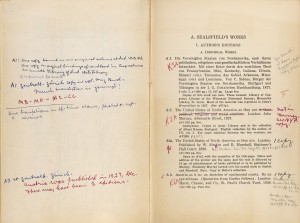 Heller, Otto, and Theodore H. Leon. Charles Sealsfield: bibliography of his writings … St. Louis: Washington University 1939.
Heller, Otto, and Theodore H. Leon. Charles Sealsfield: bibliography of his writings … St. Louis: Washington University 1939.
This interleaved copy was heavily annotated, first by Otto Heller and then by Karl Arndt, with additions, corrections, and notes.
